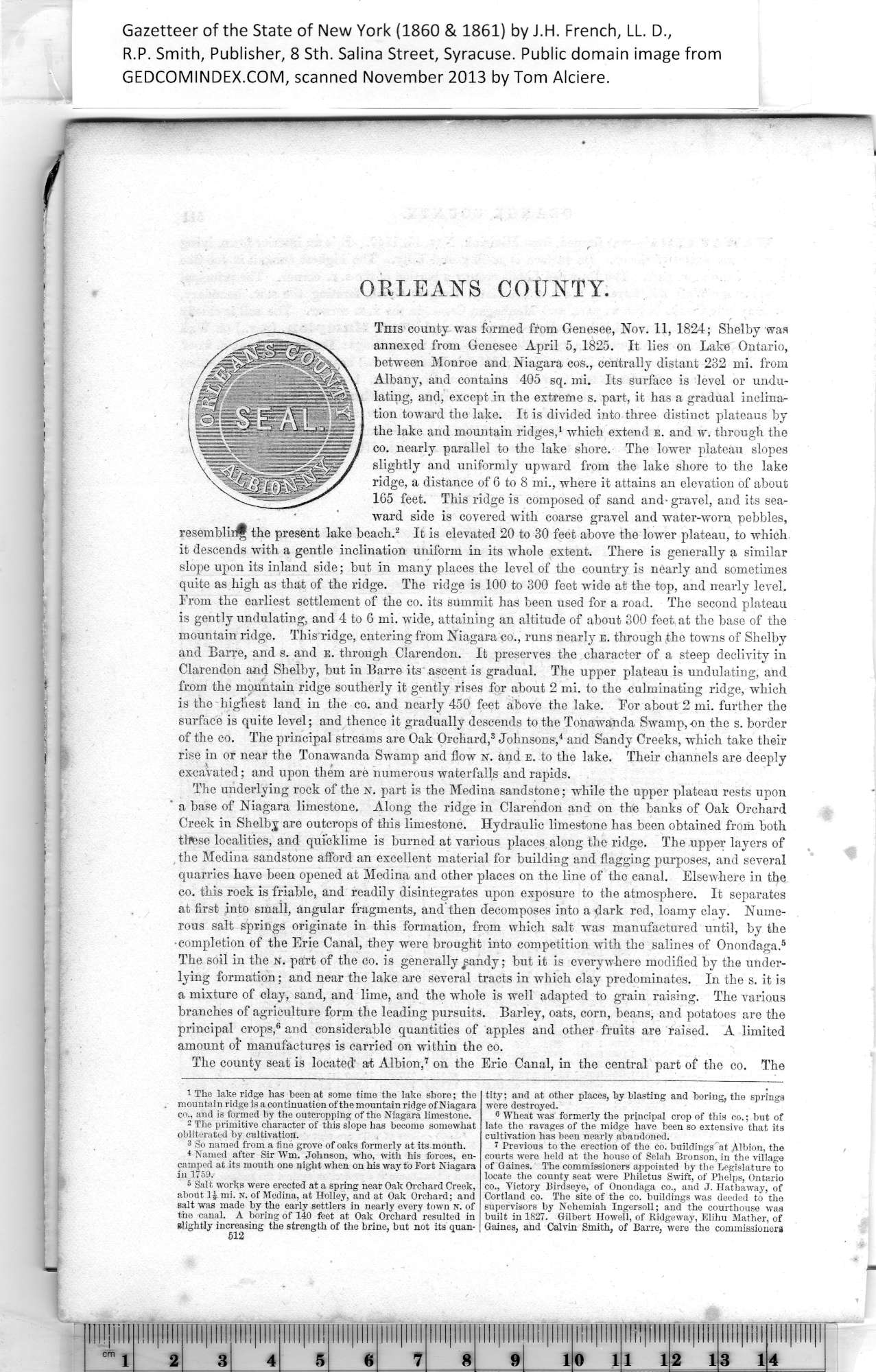|
ORLEANS COUNTY.
This county was formed from Genesee, Nov. 11, 1824; Shelby was
annexed from Genesee April 5, 1825. It lies on Lake Ontario,
between Monroe and Niagara cos., centrally distant 232 mi. from
Albany, and contains 405 sq. mi. Its surface is level or undu¬
lating, and, except in the extreme s. part, it has a gradual inclina¬
tion toward the lake. It is divided into three distinct plateaus by
the lake and mountain ridges,1 which extend e. and w. through the
co. nearly parallel to the lake shore. The lower plateau slopes
slightly and uniformly upward from the lake shore to the lake
ridge, a distance of 6 to 8 mi., where it attains an elevation of about
165 feet. This ridge is composed of sand and- gravel, and its sea¬
ward side is covered with coarse gravel and water-worn pebbles,
resemblir^ the present lake beach.2 It is elevated 20 to 30 feet above the lower plateau, to which
it descends with a gentle inclination uniform in its whole extent. There is generally a similar
slope upon its inland side; but in many places the level of the country is nearly and sometimes
quite as high as that of the ridge. The ridge is 100 to 300 feet wide at the top, and nearly level.
From the earliest settlement of the co. its summit has been used for a road. The second plateau
is gently undulating, and 4 to 6 mi. wide, attaining an altitude of about 300 feet at the base of the
mountain ridge. This ridge, entering from Niagara co., runs nearly e. through the towns of Shelby
and Barre, and s. and e. through Clarendon. It preserves the character of a steep declivity in
Clarendon and Shelby, but in Barre its ascent is gradual. The upper plateau is undulating, and
from tbe mountain ridge southerly it gently rises for about 2 mi. to the culminating ridge, which
is the highest land in the co. and nearly 450 feet above the lake. For about 2 mi. further the
surface is quite level; and thence it gradually descends to the Tonawanda Swamp,on the s. border
of the co. The principal streams are Oak Orchard,3 Johnsons,4 and Sandy Creeks, which take their
rise in or near the Tonawanda Swamp and flow n. and e. to the lake. Their channels are deeply
excavated; and upon them are numerous waterfalls and rapids.
The underlying rock of the n. part is the Medina sandstone; while the upper plateau rests upon
* a base of Niagara limestone. Along the ridge in Clarendon and on the banks of Oak Orchard
Creek in Shelby are outcrops of this limestone. Hydraulic limestone has been obtained from both
tltese localities, and quicklime is burned at various places along the ridge. The upper layers of
the Medina sandstone afford an excellent material for building and flagging purposes, and several
quarries have been opened at Medina and other places on the line of the canal. Elsewhere in the
co. this rock is friable, and readily disintegrates upon exposure to the atmosphere. It separates
at first into small, angular fragments, and then decomposes into a dark red, loamy clay. Nume¬
rous salt springs originate in this formation, from which salt was manufactured until, by tbe
•completion of the Erie Canal, they were brought into competition with the salines of Onondaga.5
The soil in the N. part of the co. is generally ^sanely; but it is everywhere modified by the under¬
lying formation; and near the lake are several tracts in which clay predominates. In the s. it is
a mixture of clay, sand, and lime, and the whole is well adapted to grain raising. The various
branches of agriculture form the leading pursuits. Barley, oats, corn, beans, and potatoes are the
principal crops,6 and considerable quantities of apples and other fruits are raised. A limited
amount of manufactures is carried on within the co.
The county seat is located' at Albion,7 on the Erie Canal, in the central part of the co. The
|
tity; and at other places, hy blasting and boring, the springs
were destroyed.
6 Wheat was formerly the principal crop of this co.; but of
late the ravages of the midge have been so extensive that its
cultivation has been nearly abandoned.
1 Previous to the erection of the co. buildings at Albion, the
courts were held at the house of Selah Bronson, in the village
of Gaines. The commissioners appointed by tho Legislature to
locate the county seat were Philetus Swift, of Plielps, Ontario
CO., Victory Birdseye, of Onondaga Co., and J. Hathaway, of
Cortland co. The site of the co. buildings was deeded to the
supervisors by Nehemiah Ingersoll; and the courthouse was
built in 1827. Gilbert Howell, of Bidgeway, Elihu Mather, of
Gaines, and Calvin Smith, of Barre, were the commissioners |
1
The lake ridge has been at some time the lake shore; the
mountain ridge is a continuation of the mountain ridge of Niagara
co., and is formed hy the outcropping of the Niagara limestone.
2
The primitive character of this slope has become somewhat
obliterated by cultivation.
3
So named from a fine grove of oaks formerly at its mouth.
4
Named after Sir Wm. Johnson, who, with his forces, en¬
5
camped at its mouth one night when on his way to Fort Niagara
in 1759.
6
Salt works were erected at a spring near Oak Orchard Creek,
about IJ mi. N. of Medina, at Holley, and at Oak Orchard; and
7
salt was made by the early settlers in nearly every town tr. of
the canal. A boring of 140 feet at Oak Orchard resulted in
slightly increasing the strength of the brine, but not its quan-
512
|
